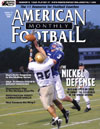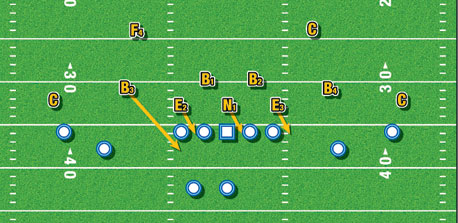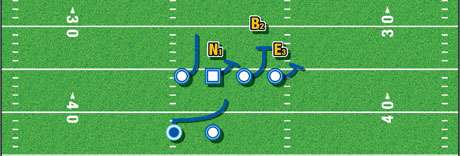AMERICAN FOOTBALL MONTHLY THE #1 RESOURCE FOR FOOTBALL COACHES
Article CategoriesAFM Magazine
|
Using Speed and Movement to Shut Down the Inside Zoneby: Tyler HainesLinebackers Coach and Special Teams Coordinator • Adrian College © More from this issue Every defensive coach knows that the Inside Zone is a base play for most offenses. There are many variations to the Zone scheme like lead, split, read, and bubble. At Adrian we start with the premise that it is important to beat the Zone from the inside out. We try to force the running back to bounce or cut back where we want. We will run down the read, bubble, and options off the Inside Zone. Here at Adrian College we believe in a smaller, faster, attacking defense that leaves the offense on their heels. Offenses hope to take away that movement and aggressiveness by running the Inside Zone. To counter this play we have developed ways to maintain our movement and aggressiveness while remaining gap sound. This is our Base 3-4 Angle Cover 3 alignment and fits (See Diagram 1).
We can roll either safety down. In this instance we would roll our free safety down to be our curl/flat player and 4 fit. Our inside linebackers and our 4 fit outside linebacker are read players. They will take their read step and fit their gaps accordingly. We will use this angle defense against anything from 10 personnel to 22 personnel. We will angle to the formation strength, weakness, field, or boundary. We try to be as unpredictable as possible when moving our front. Just by angling, we have allowed our players to be aggressive and force the offense to adjust to what we are doing. With this scheme we have installed two basic fundamentals that will help us stop the Inside Zone. Two Fundamentals 1. FAX BACKER The FAX backer is the 2 Fit LB. In our 3-4 scheme the inside linebackers read near guard to running back. We work tirelessly on proper reads. One of these reads is the Inside Zone. The FAX technique is used only for Inside Zone and no other read. This is the read the LB will get (See Diagram 2).
Now the traditional 8-gap defense would tell this backer to use his hat and hands to put the play side guard back in the hole. That’s not a position we want to put our smaller, faster LB in consistently, so we initiate the FAX technique. In diagram 2 we are telling our nose to force a cutback. He does this by showing his color heavy in the A gap. If he is getting reached or can’t force a cutback, we need to find a new nose. By the nose doing his job and forcing a cut back, the 2 Fit LB can FAX back (See Diagram 3).
There are several important coaching points to this technique. The first is that the LB must attack the guard. He then gives a quick 3-point strike (or hat and hands) to give the illusion of filling the B gap. He then is free to scrape the nose’s butt, keeping his shoulders square to the line of scrimmage, and make the play. The worst thing that can happen is the LB utilizes the FAX technique too early so the guard pins him on the back side or opens the B gap immediately to the running back. Two questions usually arise when discussing this technique. The first being do you ever get beat on the play side B gap? The honest answer is ‘no’ because it is an incredibly tough block for the center to beat the nose. The only thing the running back sees is color in the A gap and his natural instinct tells him to cut back. The second question is do you ever FAX both inside backers? We do against 12, 21, or 22 personnel. There is no need to FAX both in this instance because we have an unaccounted for crashing OLB. The bottom line is this technique will allow your LBs to be playmakers instead of gap fillers on the Inside Zone. 2. NOSE BANG The Nose Bang technique is used when the offense runs Inside Zone away from our angle (See Diagram 4).
We do not have a FAX backer because our 2 Fit LB is on the back side. There are many OL combinations to try to pick us up on the front side. The front side guard has to at least step and help with the crash end. If the guard doesn’t give enough attention to the end, then it’s his play to make. The center and back side guard combo the nose and up to the linebackers. If the center and back side guard stay on the nose, then the 1 Fit LB has to make the play. If the center chips off to the backer, as he should, the nose will make the play by using the BANG technique. This technique is executed by attacking the play side shoulder and hip of the back side guard. He then gets extension while keeping his hips square to the LOS. Then he can either use a hand over or rip move to escape the guard and pursue down the LOS. Two things might happen: one possibility is the RB sees the crash end and cuts back into our bang nose; or, he sees the crash end and bounces into our unaccounted for crash OLB. I know it is much easier to talk about these techniques than it is to teach and execute them on the field. With our players’ speed and aggressiveness these techniques have worked for us. If you have any questions or would like to discuss these techniques further feel free to contact me anytime. Thank you and I hope you have picked up something you can use! WHAT IF? Q1. What if you're facing an offense with an All-American running back and it's difficult to have him bounce or cut back the way you want? What adjustments, if any, would you make? The first thing we do when preparing to face an excellent running back is to get his tendencies through film work. Running backs have a running style. Some backs are great cut back runners and others are great bounce runners. When deciding how to beat a great running back you have to take away what he is best at. So we will spin down a safety away from our angle if he is hurting us with the cut back or the safety to the angle if he is hurting us on the bounce. That way we can get an eighth man in the box where he wants to run. Q2. What if you’re having trouble with their guards and your linebacker is pinned early on the back side? The B gap, in turn, opens up. What changes or adjustments would you make? If our linebackers are getting pinned that means we, as a coaching staff have not taught the technique right; however, sometimes we face excellent guards that just beat us. If that is the case, then we can go to a traditional eight gap scheme to keep the guard guessing when we are going to FAX or not. It is a lot easier to have the FAX technique installed and have to go to a traditional gap scheme than vice versa. Even the best guards will have to guess what we are doing when switching back and forth. Q3. What if you’re having trouble with the Nose Bang technique as the offense runs the inside zone successfully away? How do you counter? If the Nose Bang technique is not working it is usually because our nose is getting over extended by taking too large of an angle step, thus getting too much of the back side guard. So the first thing we do is tell him to shorten his step that allows him to read quicker. Obviously, most teams want to run away from our angle, so usually we will roll down our safety to the weak side. The last thing we can do to get the nose causing havoc is to mess with his alignment. Instead of being a true 0 technique we can shade him one way or the other that makes the O-line start guessing what he is going to do. As long as he is mixing it up and not getting out of position, we can let him move around. About the Author Tyler Haines enters his first season as an assistant coach for Adrian College and will work primarily with linebackers and special teams. A three-year letter winner at Defiance College at linebacker, Haines was a semifinalist for the Draddy Trophy, emblematic of being the ‘Academic Heisman’ award. He graduated from Defiance in December, 2006 with a Bachelor of Science Degree. Questions? If you have any questions you can email the author at: TylerHaines@AmericanFootballMonthly.com |
|
| HOME |
MAGAZINE |
SUBSCRIBE | ONLINE COLUMNISTS | COACHING VIDEOS |
Copyright 2024, AmericanFootballMonthly.com
All Rights Reserved








